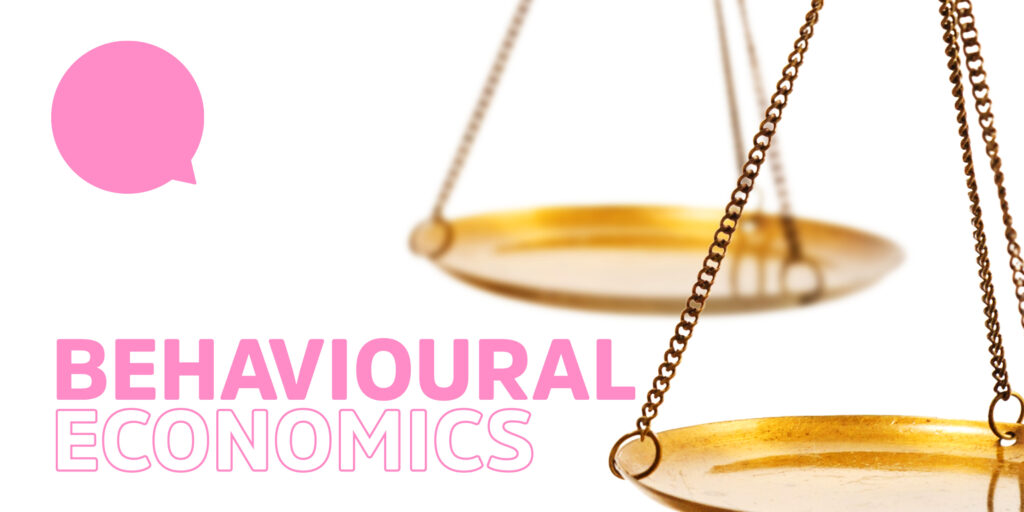How to Write Game-Changing Copy Using Behavioural Economics
24th August 2022
To be a good copywriter, you need to know more than how to string a sentence together. You have to know about humans too. The way we think, the way we behave. You’d assume that people would be rational decision-makers, that we’d look to maximise personal gain and minimise loss in every decision made, right?

Well, if that’s true then answer me this …
Have you ever paid for a gym membership that you don’t use after convincing yourself that you’ll start tomorrow? Have you ever gone over budget on a gift, a holiday or a nice little treat for yourself?
We thought so.
The point is, that this is what makes the human mind so fascinating. By understanding why people make the decisions they do, you’re gaining an understanding of ‘Behavioural Economics’, a game-changer for copywriters everywhere.
What is Behavioural Economics?
The Oxford Dictionary defines behavioural economics as:
‘A method of economic analysis that applies psychological insights into human behaviour to explain economic decision-making.’
Put simply, behavioural economics allows us to understand why people do what they do which in turn, allows us as content marketers to gently guide our audiences towards making certain decisions.
Combine behavioural economic know-how with a creative whiz with words and you have yourself a recipe for some killer content marketing copy.
But, where do you start?
Anchoring
Do you have that one item you won’t buy unless it’s on sale? £5.99 for a tub of ice cream is a no-go, but once you see that price slashed to £2.99, it’s ice cream sundaes all round. Well, the tendency for a person to heavily rely on the first piece of information they receive when making decisions is a type of cognitive bias known as anchoring.
Anchoring often plays a part in decisions that involve numerical values such as prices. So, copy masters, ensure the first piece of information you’re giving your audience feeds into the outcome you’re hoping for.
A great example of anchoring can be found in Daniel Kahneman’s book, Thinking, Fast and Slow.
A supermarket offered Campbell’s soup at 10% off its original price. However, through a careful selection of words, the supermarket was able to boost sales of the tinned soup. On some days, the supermarket had a sign which read “no limit”. When this was the case people purchased an average of 3.5 cans. However, once the sign was changed to “limit of 12 per person”, the average purchase increased to 7 cans. Using an anchor of 12 gave buyers a reason to justify such a large purchase while also creating a sense of scarcity.
This shows us that a little bit of copy can go a long way.
Framing
Growing up, many of us became familiar with the phrase “it’s not what you say, it’s how you say it”. This is true in many ways, but when it comes to behavioural economics and copywriting, positive framing is what comes to mind.
People tend to have a strong bias towards statements that sound more positive, even if the outcome is the same. For example, I’m sure you’d rather your doctor tell you that 66% of patients who take this medication experience no side effects rather than learning that 33% of patients that take the medication suffer a terrible reaction.
When it comes to copywriting, staying mindful about how you frame information and data can make a big difference to your conversion rate. Positive framing focuses on the benefits, and using positive words such as ‘saving’, ‘improving’ and ‘benefitting’ can assist in the strategic marketing of your product or service. If you’re trying to market a brand new low-fat butter, your target audience is bound to be more drawn to a spread that is 90% fat-free as opposed to one that contains 10% fat.
Loss Aversion
‘Sale ends soon’, ‘limited stock available’. Sound familiar? Of course it does. This is a trick as old as time itself, very often used in marketing. But why does it work so well? It all comes back to behavioural economics. This time, loss aversion is the culprit.
Classic economic theory suggests that people value losses and gains equally however, recent research has proved this wrong. According to present-day studies, losing things makes people twice as miserable as gaining things makes them happy. This simply lets us know that people hate losing things.
When you combine loss aversion with the panic of scarcity, you have a recipe for success. Once a potential buyer learns that the sale ends soon, they jump at the opportunity to buy as they are afraid of losing out. However, you know what they say about too much of a good thing. By overusing this form of marketing, you can begin to cause damage to your brand. You may appear as a discount brand or potentially lose your customer’s trust if they find the sale that is ending soon isn’t ending very soon at all. As with all marketing, you need to be true to your brand and tailor your messaging to align with your values and identity.
Using cognitive biases to influence your audience, you will be able to boost your copywriting skills to a whole new level. Imagine the places this transformative copy can take your content marketing. If you need a hand in developing captivating copy, contact us, our team of copywriters will be more than happy to assist.

